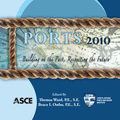Numerical Modeling to Achieve Concrete Durability for New Waterfront Structures of 100 Years or More, but at What Price?
Publication: Ports 2010: Building on the Past, Respecting the Future
Abstract
Concrete durability design need not be black magic. Technologies and products exist in the market today to achieve durability goals of 100 or even 200 years. But the key questions that must be asked are: 1.What is the cost? 2. How can we convince ourselves that we can achieve these goals? 3. What quality control measures are needed to achieve these goals? The U.S. Navy has been making pioneering advances in concrete durability modeling techniques to ensure their extensive investments in new waterfront assets are sound investments. This technology is available to all and is being used on commercial waterfront projects as well. With the advances made in numerical modeling techniques, it is now possible to quantitatively predict durability with decent accuracy. The STADIUM® model, developed by Materials Service Life of Quebec, Canada, has been adopted by the U.S. Navy as their service life model of choice for predicting marine concrete durability. The numerical model relies on the use of four "transport properties" that are tested from actual concrete samples to determine how aggressive agents such as chloride ions move through the concrete over time. The advent of this new technology now allows engineers to place more emphasis on performance specifications rather than relying only on prescriptive methods. Engineers can specify strength and durability (in terms of required design life) requirements and allow contractors to innovate to achieve the desired results. There are numerous methods of achieving enhanced durability, including adding concrete cover distance of reinforcing steel, choosing a less corrosive or non-corrosive reinforcing steel, using fusion-bonded epoxy-coated rebars, using corrosion inhibitor admixtures, applying external barrier coatings, using supplementary cementitious materials such as fly ash and silica fume, and varying the concrete mix design parameters such as water cement ratio and cement content, for example. Numerical modeling allows the engineer to evaluate the myriad options on an even playing field to determine the optimal solution. The use of a standardized service-life model also allows suppliers to innovate and develop new products to improve durability performance, knowing that they will be subject to fair and unbiased evaluation. Such innovation is sorely lacking in the U.S. construction industry at present since it can often take 10 to 15 years to bring a new product to market. Durable concrete also requires effective quality control measures in the field to ensure the final product matches or exceeds performance in the laboratory. This paper will describe the beta-testing experience and lessons learned by the U.S. Navy on a major new wharf project in a corrosive tropical environment.
Get full access to this article
View all available purchase options and get full access to this chapter.
Information & Authors
Information
Published In
Copyright
© 2010 American Society of Civil Engineers.
History
Published online: Apr 26, 2012
ASCE Technical Topics:
- Business management
- Concrete
- Concrete structures
- Contracts and subcontracts
- Engineering fundamentals
- Engineering materials (by type)
- Management methods
- Material durability
- Material mechanics
- Material properties
- Materials engineering
- Models (by type)
- Numerical models
- Practice and Profession
- Pricing
- Quality control
- Structural engineering
- Structural models
- Structures (by type)
- Waterfront structures
Authors
Metrics & Citations
Metrics
Citations
Download citation
If you have the appropriate software installed, you can download article citation data to the citation manager of your choice. Simply select your manager software from the list below and click Download.
